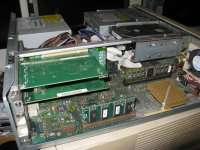Franklinstein
Well-known member
Motorola was a major developer of PowerPC-based desktop computers in the CHRP and PReP days, along with IBM and a small handful of other manufacturers. This resulted not only in PPC-based workstations such as IBM's RS/6000 and Motorola's PowerStack line, both of which were designed to run a *nix and/or WinNT 4 rather than Mac OS, but in Motorola's case, it also resulted in co-development with Apple of the Tanzania and Tanzania II-based logic boards. Motorola designed and built desktop and minitower variants of Tanzania machines and sold them under their StarMax brand, but also built them for a variety of other brands such as APS Tech and PowerTools.
When Mac OS licensing was discontinued, Motorola found themselves with a sizable stock of MacOS-compatible computers that they suddenly couldn't sell. Apparently ComJet, a German reseller, decided that they could sell unlicensed clones in their home market without legal worries. So they bought some of Moto's stock of computers, replaced the front badges with "PowerCity" badges, and resold them with virtually no other changes. Really the only suggestion that these were sold in Germany is a small sticker in German on the rear of the case near the power supply.
Among this stock of computers were a variety of mintower and desktop-style cases. The logic boards are nearly identical between the two but the MT models have onboard Ethernet and supposedly have 5 PCI slots on their riser cards as compared to the 3-slot riser on the DT models. They were both available with a 604e in speeds from 160 to 200MHz (though possibly up to 240MHz; it's hard to get official info on these).
The DT was a competent machine for 1997/98 as it included 32MB of RAM and 512k L2 cache from stock, but it was crippled with a 4500RPM hard drive and a lack of onboard Ethernet. Also, most of the drive expansion slots are fake: the top 3.5" bay contains the hard drive, and the bottom 3.5" bay doesn't exist; only the second 5.25" bay is usable, and only then if you use an add-on controller card or make some changes to the onboard SCSI bus (which, like the 4400, is configured to use its only SCSI port to provide external SCSI).
In a comparison with the 4400, these are faster and slightly more expandable owing to their three full PCI slots instead of 2 PCI + 1 CS II slot. If they included onboard Ethernet it would free up yet another slot, but that point is moot if you want more than 10bT anyway. Memory is still hardware limited to 32+64+64MB for a 160MB maximum thanks to its odd memory arrangement, though its use of PC-standard unbuffered 3.3v EDO DIMMs makes it easier and less expensive to find RAM compared to contemporary Macs with their 5v buffered RAM.
The floppy drive is a standard Apple GCR Mitsubishi unit with a special bezel on it.
Like other clones, these do include PS/2 ports in addition to ADB.
Video is provided by the Tanzania-standard ATI Mach64. Stock VRAM is 2MB EDO, expandable to 4MB SGRAM by replacing the video memory card. A GIMO slot is provided for use with a PC Compatibility Card.



When Mac OS licensing was discontinued, Motorola found themselves with a sizable stock of MacOS-compatible computers that they suddenly couldn't sell. Apparently ComJet, a German reseller, decided that they could sell unlicensed clones in their home market without legal worries. So they bought some of Moto's stock of computers, replaced the front badges with "PowerCity" badges, and resold them with virtually no other changes. Really the only suggestion that these were sold in Germany is a small sticker in German on the rear of the case near the power supply.
Among this stock of computers were a variety of mintower and desktop-style cases. The logic boards are nearly identical between the two but the MT models have onboard Ethernet and supposedly have 5 PCI slots on their riser cards as compared to the 3-slot riser on the DT models. They were both available with a 604e in speeds from 160 to 200MHz (though possibly up to 240MHz; it's hard to get official info on these).
The DT was a competent machine for 1997/98 as it included 32MB of RAM and 512k L2 cache from stock, but it was crippled with a 4500RPM hard drive and a lack of onboard Ethernet. Also, most of the drive expansion slots are fake: the top 3.5" bay contains the hard drive, and the bottom 3.5" bay doesn't exist; only the second 5.25" bay is usable, and only then if you use an add-on controller card or make some changes to the onboard SCSI bus (which, like the 4400, is configured to use its only SCSI port to provide external SCSI).
In a comparison with the 4400, these are faster and slightly more expandable owing to their three full PCI slots instead of 2 PCI + 1 CS II slot. If they included onboard Ethernet it would free up yet another slot, but that point is moot if you want more than 10bT anyway. Memory is still hardware limited to 32+64+64MB for a 160MB maximum thanks to its odd memory arrangement, though its use of PC-standard unbuffered 3.3v EDO DIMMs makes it easier and less expensive to find RAM compared to contemporary Macs with their 5v buffered RAM.
The floppy drive is a standard Apple GCR Mitsubishi unit with a special bezel on it.
Like other clones, these do include PS/2 ports in addition to ADB.
Video is provided by the Tanzania-standard ATI Mach64. Stock VRAM is 2MB EDO, expandable to 4MB SGRAM by replacing the video memory card. A GIMO slot is provided for use with a PC Compatibility Card.



